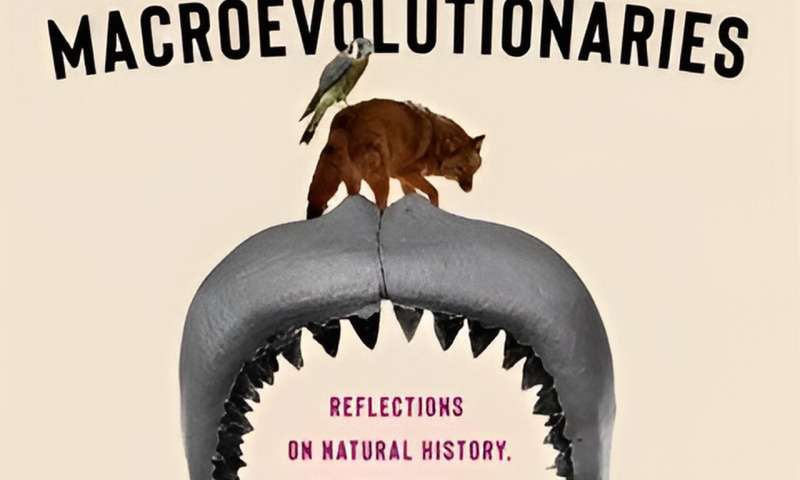New book explores intersection of evolution, art and popular culture

A new book of natural history essays co-written by a University of Kansas paleontologist has been published by Columbia University Press.
Bruce Lieberman, Dean's Professor of Evolutionary Biology and senior curator of invertebrate paleontology at KU, co-wrote "Macroevolutionaries" with fellow paleontologist Niles Eldredge in the tradition of their late Harvard mentor and famed science popularizer, Stephen Jay Gould.
"Gould inspired me and my collaborator on the book, Niles Eldredge," Lieberman said. "He's a well-known evolutionary biologist who, along with Gould, developed many important ideas in evolution, the most famous being 'punctuated equilibria." This idea, developed about 50 years ago by paleontologists, explains the overall patterns of evolution we see in the fossil record."
Gould, who died in 2002, was a prolific writer and essayist who boosted popular understanding of science via monthly columns in Natural History magazine and several bestselling books for a popular audience.
"His essays were designed to be accessible and discussed interesting issues in natural history, paleontology and evolution," Lieberman said. "Niles and I are trying to revive the natural history essay for a new audience and generation, focusing on paleontology, natural history, and the connections between paleontology, science, popular culture, music and art. I'm excited that we get to mention people like Miles Davis and Art Blakey in the book. We're trying to make it accessible and get people thinking about the connections between science and art."
Chapters in "Macroveolutionies" touch on cultural icons as varied as "The Three Musketeers," baseball player and manager Yogi Berra, fictitious TV stuntman Super Dave Osborne, Shakespeare's "Hamlet," gossip columnist Walter Winchell and jazz musicians.
"One of the chapters we have is an essay on the evolution of the trumpet and the cornet and how the designs of the cornet have changed through time," Lieberman said. "We focus on how they resemble and differ from the evolutionary process on the biological side. We examine any differences between cultural evolution or evolution in the technosphere and biological evolution."
Repeatedly, the co-authors examine the idea of punctuated equilibria, first conceived by Gould and Eldredge.
"The traditional view on evolution, as described in Darwin's 'On the Origin of Species' and since, is that a species starts as one thing and then slowly and gradually changes into another type over time," Lieberman said. "For example, one type of finch slowly transforms into another species of finch.
"By contrast, the punctuated equilibria idea, which better fits what we see in the fossil record, suggests species remain mostly the same throughout most of their history. They don't appear to change much, with most species in the fossil record lasting for several million years. Then, over a relatively quick interval—maybe a few thousand to tens of thousands of years—they change, usually in response to a population becoming geographically isolated. These conditions encourage divergence."
Lieberman said that most species change little over 90% to 95% of their existence, but then undergo more rapid periods of change, perhaps branching away into entirely new species in just thousands of years.
Another theme running through "Macroevolutionaries" is the importance of mass extinctions to evolutionary processes.
"One of those essays is called 'Star Dust Memories,' which explores the role that astronomical factors may play in driving mass extinctions," Lieberman said.
"We discuss why mass extinctions are important and note that over the last 500 million years, there have been somewhere between about five and 15 mass extinctions. Mass extinctions involve most species doing fine and then suddenly, over a relatively short interval, experiencing a dramatic cataclysm that wipes out many species. This introduces an important element of chance into the history of life."
For example, the KU researcher said the space rock that killed off the dinosaurs and so many other species some 66 million years ago also was a creative force that led to the rise of mammals on Earth, including humans.
"When a giant rock slammed into the planet, it caused tremendous environmental changes," Lieberman said. "No matter how well adapted a species was, it couldn't survive getting hit by a 6-mile-wide asteroid. This event displaced successful species and allowed other groups, such as mammals, to rise. Before the extinction of the dinosaurs, mammals were relatively small. Within about 10 million years of the extinction event, diverse mammals like bats and whales had evolved. Thus, mass extinctions displace successful species and allow other species to emerge, although this process can take millions of years."
The book ends with a tribute to trilobites, extinct marine arthropods that thrived in the Paleozoic Era, about 521 to 252 million years ago.
"The last chapter explores why we love trilobites so much and why we think Walter Winchell wouldn't have loved them," Lieberman said. "As usual, we incorporate famous or infamous media personalities to discuss these topics. Trilobites were incredibly successful and highly diverse for around 300 million years. Ultimately, a series of mass extinctions eliminated them. Trilobites offer a window back to a different time when a completely different set of life forms were successful. Now, nothing like them exists anymore. It's fascinating to think about what made them so successful and why they ultimately failed."
In the tradition of Gould, Lieberman said he hoped the book would appeal to a broad readership.
"He tried to relate broader human societal patterns to his work, showing his talent for making connections," Lieberman said. "Making connections is increasingly difficult as everything becomes more specialized. While specialization is beneficial, it's also important to step outside and think about how different ideas relate.
"In our book, we aimed to show how developments in music, for example, can be analogous to how we understand biology, or how phenomena in distant stars can affect patterns of extinction on Earth. We wanted to make these connections clear. We also aimed to keep the book light and humorous. Our goal was to make the book learned on one hand, and accessible and humorous on the other."
Provided by University of Kansas